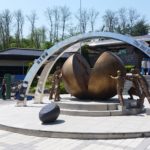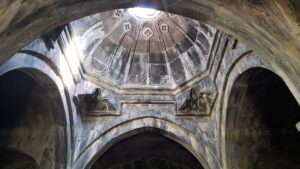In brief: For South (and likely North) Koreans, memories of war, of division are still strongly emotional and whose hopes for reunion, for peace still endure.

We seized the opportunity to visit the DMZ (the demilitarized zone) of Korea, a 4 kilometer (2.5 mile) wide piece of land that has been the negotiated, patrolled and often incendiary border area dividing North and South Korea since 1953. The zone is just an hour’s drive away from Seoul.
The DMZ is emotional soil for South (and likely North) Koreans who are free to visit but not to cross. For them, the border recalls 65 years of threats from the north, separated families and trapped fellow Koreans – as well as wartime hardship. 80% of Korea was destroyed in the 1950s war as the North Koreans, Chinese forces, and the US swept up and down the peninsula.

Those are the kinds of memories kept tangible around the Freedom Bridge, one of two destroyed rail bridges that had connected north and south. It was rebuilt – and renamed – to transport over 12000 POWs from the north in 1953. Now useless, it symbolizes the desire to make the connection with the north anew. We saw several hopeful memorials in the vicinity of the bridge, along with tattered pennants and locks placed at the site by Korean visitors – as well as a rusting train engine shattered by bombs in the war.
Some features of the ongoing rivalry are more frivolous.
From the south, the only towns visible are show towns for tourists to glimpse the wonderful conditions of northern Korean life. The towns are completely dark at night. Amidst them, a huge statue of former premier Kim Jong-Il continues to wave in the distance, but is nearly impossible to find in the landscape.

The North Korean flagpole near the actual border soars 160 meters up, 60 meters higher than the South Korean flagpole on the other side of the border. These resulted from the flagpole wars of the past, with each side raising the height. When the south’s flagpole reached 100 meters (about 300 yards), the north went 60 meters further. The south conceded victory. The North Korean flag is so heavy it doesn’t even move in strong winds. The North may have won the flagpole war, but, partly due to economic sanctions imposed by western powers, southern GNP has outclassed northern economic development 50-fold since the Korean War.
Both sides are still armed, with a huge persistent presence of US military on one side, and on the other a North Korean force well-stocked by China. Formally, the Korean War has not even ended yet through the signing of a permanent truce.
The DMZ has often welcomed the dove of peace and potential union between the two Koreas; just recently peace talks pre-occupied the border town of Panmunjom for some months. Because of the talks, we were not able to visit the famous Peace House right at the border. Sadly, each time global politics or outbreaks of violence have chased the dove away. Within the last decade, for example, a joint effort of developing and working a factory failed after several workers from the south were killed.

Early on, for example, North Koreans dug at least four extensive tunnels below the DMZ into the south, potential avenues for attack. The part of Tunnel 3 south of the DMZ, along with the tunnel dug by the US to intercept it, has been turned into relatively elegant passageway for tourists. Another hopeful sculpture depicting the dream of unification, the ongoing effort to put the pieces of Korea back together, sits alongside the Tunnel’s large parking lot and near numerous souvenir shops. Historical exhibits near the entrance discuss the North’s digging and South’s detection methods in a sort of subway war.
The Tunnel 3 “experience” ends within a stone’s throw of the actual border, yet a wall blocks further progress or even a glimpse of the other side. It’s a bit stupid, we felt, to spend so much nearly an hour of a visit to the DMZ walking down and back up the steep slope of the intercept section or traipsing hunched over along with hundreds of others down the main tunnel, since you don’t learn much after the first few steps.
Despite the failure of peace efforts, occasional violence, and the continuing presence of walls between the countries, 70% of South Koreans remain optimists regarding peace and even reunification, like Germany’s in the 1990s. Others still consider leadership in the North crazy rather than rational in its geo-political calculations. One wonders whether the current leader, Kim Jong-Un, threats of nuclear weapons and arms are just a new version of those tunnels.

For its part, in the early 2000s, the South extended its high-speed train line to the southern edge of the DMZ, fully expecting it to continue through the North and form an economic bridge to China, Russia and the East. An optimistic George W. Bush showed up to christen the station. The line still stops here. Some recent news stories report that the south has offered to invest in both the extension through North Korea and other economic support. Pessimists note that the North and South collaborated on a few factories in the DMZ, but a missile killed some of the South Korean workers about a dozen years ago. The factory closed.
For a foreigner, a DMZ visit can be quite rushed and rigidly organized. Worse, the commercial activity centered on the bus-loads of visitors makes it all feel tourist frou-frou, souvenirs rather than remembrance – with such items for sale as DMZ hats and t-shirts, DMZ wines and fridge magnets, etc. Despite such trivializing, we still felt the underlying heartache of history and the danger encapsulated here. We could witness the blocked transit of the old Freedom Bridge, still awaiting re-connection; observe the stringent credential checks for visitors; and meditate on the many memorials – from bronze statuary to prayer locks and personal notes – all hoping for reunion, for peace.
(Also, for more pictures from Korea, CLICK HERE to view the slideshow at the end of the itinerary page.)






